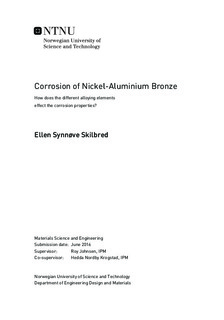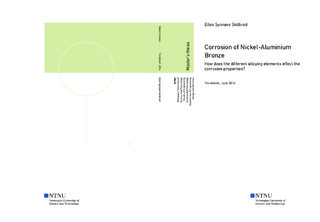| dc.description.abstract | This thesis examines the effect of copper, aluminium, iron and nickel on the corrosion properties of Nickel-Aluminium bronze (NAB) in seawater. NAB has a complex microstructure consisting of a copper-rich phase, α, and several intermetallic phases, κ. NAB is documented to be susceptible to selective phase corrosion (SPC), where different phases corrode at different pH levels. The stability of aluminium oxide is assumed to cause this pH-dependency. However, the behaviour of aluminium is known to be generally unstable in seawater, thus a more thorough examination of the issue is of interest. The NAB alloy examined was characterized to find the amount of each element in each phase and the volume fraction of copper-rich and intermetallic phases. Several corrosion experiments were performed in synthetic seawater (SSW) to shed light on the corrosion behaviour of NAB at different potentials and pH, as well as the effect of the main alloying elements on the corrosion properties of NAB. Aluminium oxide was established to be unstable in SSW with pH<6, whereas partially hydrated nickel oxide displayed stability in the same region as NAB. This indicates that nickel may contribute to passivity of NAB. It is thus suggested that the passivity of NAB is attributed the formation of a passive layer of aluminium oxide that is stabilized by the presence of nickel. When the passive film is stable, the corrosion properties are dominated by corrosion of copper. When the film is unstable, intermetallic phases corrode actively which decreases the open circuit potential (OCP). At pH<4, the copper-rich phase is galvanically protected until the surface is depleated from iron-rich intermetallic phases, or as long as the potential of the surface is kept below the OCP of copper. The alloy s iron is mainly situated in small, iron-rich intermetallic particles and these have not appeared detrimental for NAB, as they are embedded in other phases that are not iron-rich. Iron is thus not concidered to inflict singificant corrosion problems for the microstructure examined in this thesis. The main concern of corrosion at pH<4 is the continuous intermetallic phase, which is nickel- and aluminium-rich. If NAB is to be used in seawater and there is a possibility that it will be subject to pH<4, like during crevice corrosion or if covered by marine debris, heat treatment is suggested to make sure all intermetallic phases are discontinuous near the surface. Then, the corrosion propagation will probably to a greater extent be determined by the copper-rich phase, which has a slower corrosion rate than the intermetallic phases. | |

